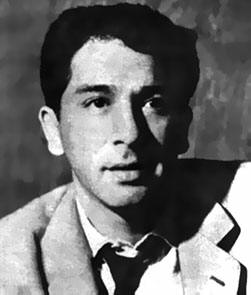

Queer Places:
Windsor Apartments, Calle 2 de Abril, Centro Histórico de la Cdad. de México, Guerrero, 06300 Ciudad de México, CDMX
 Sergio Magaña (September 24, 1924 – August 23, 1990) was a Mexican playwright, theater critic, columnist, and writer, who cultivated various genres, among which dramaturgy and criticism stand out.
Sergio Magaña (September 24, 1924 – August 23, 1990) was a Mexican playwright, theater critic, columnist, and writer, who cultivated various genres, among which dramaturgy and criticism stand out.
Sergio Magaña grew up in the brave neighborhoods of the capital. He studied at the UNAM: two years in the career of Law and English Letters in the Faculty of Philosophy and Letters in addition to theater. He participated in the student theater group Athena in 1946, within the same faculty. There he participated in various activities with Emilio Carballido, Luisa Josefina Hernández, Miguel Guardia. He received classes from Rodolfo Usigli and Seki Sano. He had strong altercations with Usigli, who ran him out of his dramatic composition class for disrespecting him. He was a professor at the School of Dramatic Art of the INBA and directed the School of Fine Arts in Oaxaca. He participated within the diplomatic corps of the Mexican embassy in Bogotá as a cultural advisor. He collaborated in the magazines América de Roberto Guzmán Araujo and in Mañana, as well as in the supplements of the newspapers Excélsior and Ovaciones. He worked as a plot artist for the comic strip Watusi. He is considered part of the half-century generation of Mexican literature. He won the National Prize of El Nacional with El molino del aire in 1953, the Manuel Eduardo de Gorostiza Award with Los motivos del lobo, 1965 and the Prize of the Association of Theater Journalists with Los enemigos in 1989.
In the 1950s, apartments that were designed for singles and couples attracted gay men. Demand for small apartments grew by the mid-1950s, with many new residential projects offering smaller units. The Unidad Habitacional Santa Fe, which opened in 1956, configured some 20 per cent of its space as one-bedroom and studio flats. Architects’ illustrations and floor plans envisioned different types of family occupying these apartments, with the one-bedroom units often holding a full-size bed (for a bachelor or a couple), or twin beds (for roommates), and living rooms capable of seating five individuals and dining space for four. Studio apartments were configured with a sleeping alcove accommodating a full-size bed; a living room with two chairs and a sofa; and a kitchenette with a small table and two chairs. These flats attracted middle- and lower-middle-class individuals – clerks, minor functionaries and teachers – who paid less than 25 per cent of their monthly income in rent. In response to demand for small modern apartments, private investors developed affordable studio apartments that could be leased for as little as $100 pesos per month, such as Jorge Rubio’s Windsor Apartments. Conceived as a luxury hotel in the 1940s to lodge touring orchestras, opera and ballet companies performing at the Bellas Artes Theatre, the Windsor was converted into apartments in the 1950s, with small kitchenettes concealed behind a partition wall and a closet separating the bathroom from the multifunction main room. These units attracted gay professionals and artists, including couturier Armando Valdés Peza and playwright Sergio Magaña. Although spartan by bourgeois standards, apartments such as these transformed the lives of a man like Magana, giving him a home close to the theatres where he worked, allowing him to host friends and co-workers and giving him the type of privacy he lacked as a rural migrant living in tenements with his family.
My published books: